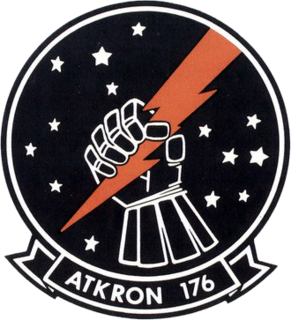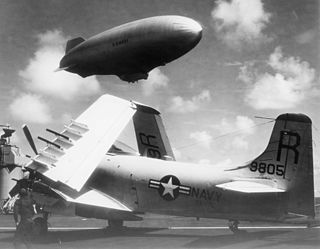
Attack Squadron 176 (VA-176), known as the "Thunderbolts", was a United States Navy carrier-based medium attack squadron that saw combat service in the Vietnam War and later in 1983 in both Grenada and Lebanon.

The Grumman TBF Avenger is an American torpedo bomber developed initially for the United States Navy and Marine Corps, and eventually used by several air and naval aviation services around the world.

Torpedo Squadron 8 (VT-8) was a United States Navy squadron of World War II torpedo bombers. VT-8 was assigned initially to the air group of the aircraft carrier USS Hornet, joining the ship shortly after her commissioning in October 1941.

Strike Fighter Squadron 25 (VFA-25) is an aviation unit of the United States Navy based at Naval Air Station Lemoore, California. The squadron flies the Boeing F/A-18E Super Hornet and is currently assigned to Carrier Air Wing Seven, tail code AG. Its callsign is Fist.

A carrier air wing is an operational naval aviation organization composed of several aircraft squadrons and detachments of various types of fixed-wing and rotary-wing aircraft. Organized, equipped and trained to conduct modern US Navy carrier air operations while embarked aboard aircraft carriers, the various squadrons in an air wing have different but complementary missions, and provide most of the striking power and electronic warfare capabilities of a carrier battle group (CVBG). While the CVBG term is still used by other nations, the CVBG in US parlance is now known as a carrier strike group (CSG).

Strike Fighter Squadron 115 (VFA-115) is known as the "Eagles", callsign "Talon", a United States Navy F/A-18E Super Hornet strike fighter squadron stationed at Marine Corps Air Station Iwakuni. Their tail code is NF. It was established as Torpedo Squadron VT-11 on 10 October 1942, redesignated VA-12A on 15 November 1946, VA-115 on 15 July 1948, then finally VFA-115.

Attack Squadron 65 (VA-65), nicknamed The World Famous Fighting Tigers, was an attack squadron of the United States Navy. The squadron was established as Torpedo Squadron VT-74 in 1945, redesignated as VA-2B in 1946, as VA-25 on 1 September 1948, and finally redesignated VA-65 on 1 July 1959. It was disestablished in 1993. Known as "The World Famous Fighting Tigers", VA-65 was one of the last medium attack squadrons to fly the A-6 Intruder and the A-1 Skyraider. It was the second squadron to be designated VA-65, the first VA-65 was redesignated from VA-6B on 27 July 1948 and would be redesignated as VA-25 on 1 July 1959.

Strike Fighter Squadron 195 (VFA-195), also known as the "Dambusters", is a United States Navy F/A-18E Super Hornet fighter squadron stationed at Marine Corps Air Station Iwakuni, Japan. They are a part of Carrier Air Wing Five (CVW-5) and their tail code is NF. Their radio callsign is "Chippy".

Sea Control Squadron 22 (VS-22) Checkmates was a carrier-based United States Navy squadron based out of Naval Air Station Jacksonville in Florida. The squadron flew the Lockheed S-3B Viking and their mission was mining, undersea and surface warfare, electronic reconnaissance and analysis, over the horizon targeting, and aerial refueling. The squadron was last attached to Carrier Air Wing Seventeen (CVW-17) and was the last squadron flying the Viking. VS-22 was disestablished in a ceremony at NAS Jacksonville on January 29, 2009, and officially on March 31, 2009.
VC-10 Composite SquadronChallengers was a United States Navy aircraft squadron. It was originally known as the Mallards in 1943, but when assigned the F-8 Crusader the squadron pilots unofficially used the name "Challengers". The squadron was formally known as the Challengers from 1961 through 1993.
Attack Squadron ONE L (VA-1L) was a United States Navy squadron used to evaluate weapons and equipment and develop new tactics for the fleet under command of Light Carrier Air Group One (CVLG-1) aboard the USS Saipan (CVL-48). Originally established as Torpedo Squadron FIFTY EIGHT (VT-58) on 19 March 1946 at Naval Auxiliary Air Station Fentress in Chesapeake, Virginia, it was redesignated VA-1L on 15 November 1946 and ultimately disestablished on 20 November 1948. The squadron was the only one to receive the designations VA-1L or VT-58.

Attack Squadron 35 (VA-35) was an aviation unit of the United States Navy. The squadron's nickname is unknown. Its insignia, a winged dragon, was revised several times during its lifetime. The squadron was first established as Torpedo and Bombing Squadron 2 (VT-2) on 6 July 1925, and was redesignated as VT-2B on 1 July 1927, VT-3 on 1 July 1937, VA-4A on 15 November 1946, and, finally, VA-35 on 7 August 1948. The squadron was disestablished on 7 November 1949. It was the first squadron to carry the VA-35 designation, the second VA-35 was redesignated from VA-34 on 15 February 1950 and disestablished on 31 January 1995.

VA-55 was an Attack Squadron of the U.S. Navy. It was established as Torpedo Squadron VT-5 on 15 February 1943, redesignated VA-6A on 15 November 1946, and finally designated VA-55 on 16 August 1948. The squadron was disestablished on 12 December 1975. It was the first squadron to be designated VA-55, the second VA-55 was established on 7 October 1983 and disestablished on 1 January 1991.
VA-75, nicknamed the Carrier Clowns, was an Attack Squadron of the U.S. Navy. It was established as Torpedo Squadron VT-18 on 20 July 1943. The squadron was redesignated as VA-8A on 15 November 1946, and finally as VA-75 on 27 July 1948. It was disestablished on 30 November 1949. A second squadron also bore the VA-75 designation.
VA-95 was an Attack Squadron of the U.S. Navy. It was established as Torpedo Squadron VT-20 on 15 October 1943, and as VA-10A on 15 November 1946. It was finally redesignated as VA-95 on 12 August 1948. The squadron was disestablished on 30 November 1949. Its nickname is unknown.
VA-135 was an Attack Squadron of the U.S. Navy, nicknamed Uninvited. It was established as Torpedo Squadron VT-81 on 1 March 1944, redesignated VA-14A on 15 November 1946, and finally designated VA-135 on 2 August 1948. The squadron was disestablished on 30 November 1949. A second squadron bore the VA-135 designation in 1961-1962; the squadrons were not related.

VA-175, nicknamed the Devil's Diplomats, was an attack squadron of the U.S. Navy. It was established as Torpedo Squadron VT-82 on 1 April 1944, redesignated as VA-18A on 15 November 1946, and as VA-175 on 11 August 1948. The squadron was disestablished on 15 March 1958.

Carrier Air Wing Thirteen (CVW-13) was a carrier air wing of the United States Navy established for a short period at the end of the Cold War. There were three previous units which had been named Carrier Air Group Thirteen (CVG-13), dating as far back as 1942, though each of these units has a distinct lineage.
Fighter Squadron 71 or VF-71 was an aviation unit of the United States Navy. Originally established as VGS-18 on 15 October 1942, it was redesignated VC-18 on 1 March 1943, redesignated as VF-36 on 15 August 1943, redesignated as VF-18 on 5 March 1944, redesignated as VF-7A on 15 November 1946, redesignated as VF-71 on 28 July 1948 and disestablished on 31 March 1959.
Carrier Air Group Seventeen (CVG-17) was a designation used by the United States Navy to identify two unrelated Carrier Air Groups; the first of which was established on 1 January 1943 as Carrier Air Group Seventeen and disestablished on 1 April 1992 as Carrier Air Wing Six; and the second of which was established as Carrier Air Group Eighty Two on 1 April 1944 and ultimately disestablished as Carrier Air Group Seventeen on 16 September 1968. Neither group shares a lineage with the current Carrier Air Wing Seventeen (CVW-17) as the first was the forerunner of CVW-6 and the second was disestablished eight years before CVW-17 was established.


















